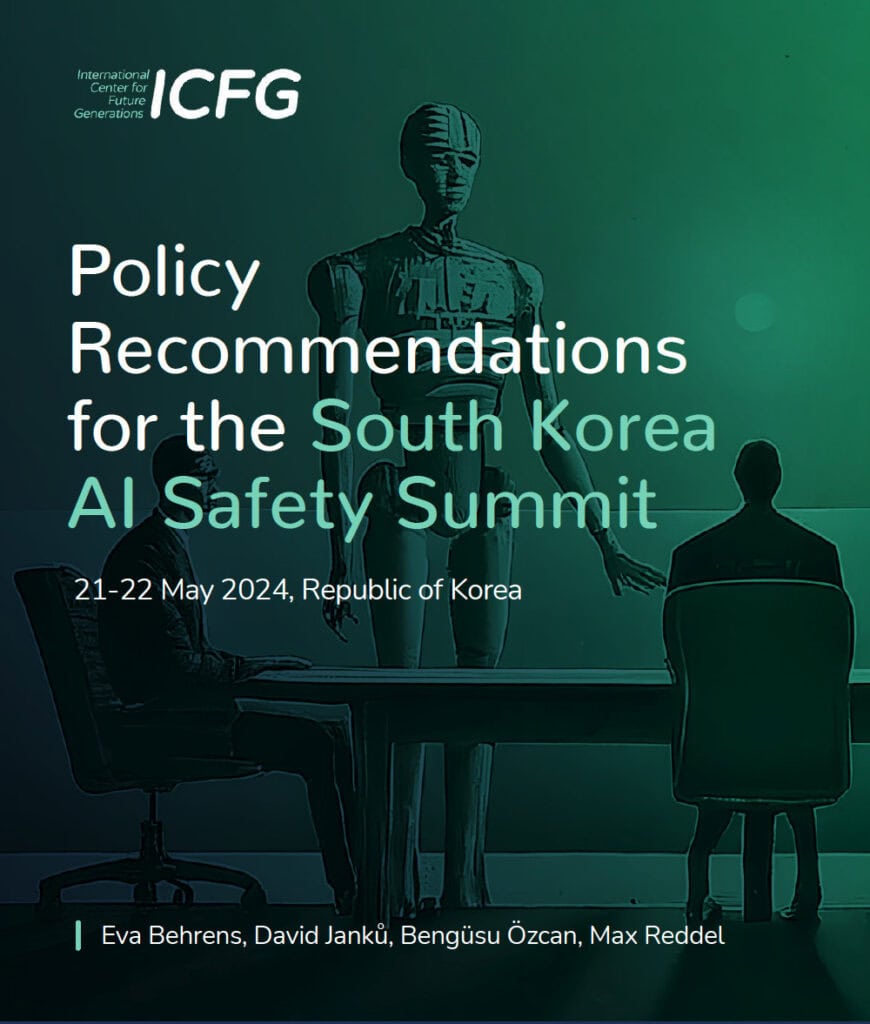
Policy Recommendations for the South Korea AI Safety Summit
Note: The 10^25 FLOP threshold chosen within this piece was chosen to represent the “unknown frontier” of AI systems, where models developed above this threshold have unknown capabilities and levels of safety. If and when models are released at or above this threshold and are eventually considered to be safe, this threshold should be raised to keep the focus of these recommendations on the frontier of AI systems of unknown safety or capability.
What is ‘frontier artificial intelligence’ and why were international leaders sufficiently concerned by it to attend a two-day summit?
International leaders and artificial intelligence (AI) experts agreed last week to support scientific research into AI safety “to ensure that the benefits of the technology can be harnessed responsibly for good and for all”. The agreement followed a two-day summit, the first of its kind in the world, hosted by the UK and attended by representatives from 28 countries as well as leading industry representatives and AI experts.
The result of the summit was the Bletchley Declaration, so-called because the meeting took place at Bletchley Park, the country estate 50 miles north west of London that was the centre of British code breaking efforts during the Second World War. Among the leaders of that wartime work was Alan Turing, whose computer science achievements helped lay the foundations for modern AI.
Turing, who once warned that “once the machine thinking method had started, it would not take long to outstrip our feeble powers”, would probably have approved of the summit’s caution. Those at the summit argued that “particular safety risks arise at the ‘frontier’ of AI” and identified particular risk in areas such as biotechnology and cybersecurity.
What concerned attendees is not the AI that recommends your best route to work or the AI that identifies your face to unlock your phone. The concern is “frontier AI” – but what is it and why is it special enough for British Prime Minister Rishi Sunak and his team to decide it needs an entire summit?
Overview
In accordance with the shared intent communicated through the Bletchley Declaration to deepen international cooperation where necessary and mitigate catastrophic risks from advanced AI, we urge countries attending the Summit in South Korea to jointly recognise that:
- … the development of so-called long-term planning agents (LTPAs) should be prohibited until proven safe,
- … advanced AI models trained on 10^25 Floating Point Operations (FLOP) of compute capacity or more should be considered high-risk and need to be regulated accordingly, and
- … the open-sourcing of advanced AI models trained on 10^25 FLOP or more should be prohibited.
To build a strong foundation for international cooperation on the governance of high-risk advanced AI, we urge that Summit participants jointly agree to:
- … hold biannual international AI Safety Summits, and pick a host country to follow after France and
- … keep the focus of the Summits on international collaboration for mitigating catastrophic risks from advanced AI.
Steps Towards Safety-First International AI Governance
1. The development of “Long-Term Planning Agents” (LTPAs) should be prohibited until proven safe.
The term “long-term planning agents” (LTPAs) refers to AI systems capable of devising and executing complex and multi-step strategies based on human-assigned reward mechanisms and self-generated internal goals that are not transparent to their human creators. LTPAs bear significant control risks as they can diverge from human intent and develop their own opaque, potentially harmful goals, a concern mentioned in the Bletchley Declaration. Current testing and evaluation methods for advanced AI cannot clearly document or predict such emergent internal goals that LTPAs might develop.
We recommend that the signatories of the Summit declaration commit to prohibiting the development of LTPAs until and if developers know how to build understandable, transparent, fully controllable LTPAs. This measure would not undermine the potential future benefits of LTPAs but relies on a precautionary framework under which safety measures precede the development of high-risk technology.
2. AI models trained on 10^25 FLOP or more should be considered high-risk and regulated accordingly.
The Bletchley Declaration underscored a global commitment to mitigate the potentially catastrophic harms of high-risk AI; however, signatories did not yet agree on criteria to distinguish high-risk AI systems, systems that pose catastrophic risks, from other types of AI.
Training highly capable, high-risk AI models requires substantially more compute resources than training other types of AI models. Therefore, compute makes for a quantifiable, measurable lever that can be used for governance tools directed only at the most capable AI models.
We urge summit participants to officially recognize a compute threshold of 10^25 Floating Point Operations (FLOP) of compute capacity used in training as a classification criterion for high-risk AI models. This threshold builds on the US Executive Act and the EU AI Act, which outline some reporting requirements for training runs above 10^26 FLOP and 10^25 FLOP, respectively. Agreeing on a specific compute threshold ensures a consistent, transparent baseline for distinguishing the small number of high-risk AI models from all other types of AI. This distinction builds a shared international foundation for future regulatory frameworks targeting high-risk AI models without impacting other types of AI.
As algorithms and hardware components improve over time, this threshold must be revised and adjusted downwards periodically to remain effective.
3. The open-sourcing of high-risk AI systems should be prohibited.
Advanced AI development requires significant investment and expertise. Yet, once trained and deployed, the distribution and utilization of such models for harmful purposes can be relatively low-cost if the source code and model weights are openly accessible. Despite the promising beneficial applications, high-risk AI systems can be used for persuasion, generating powerful bioweapons or executing cyberattacks, which makes the distribution of these models a matter of national and global security.
Therefore, we recommend that summit participants commit to prohibiting the open-sourcing of high-risk models, meaning models trained on 10^25 FLOP or more. A robust and adequate open-sourcing security protocol tailored for the distributed nature of this technology should be a priority of future Summits. Such a limit on open-sourcing would not impede most innovation and scientific research reliant on open-source AI models, as the size and nature of AI models in these contexts typically do not meet the high-risk classification outlined above.
Towards the Summit in France and Beyond
4. Participants should commit to holding biannual AI Safety Summits.
The AI Safety Summit is a valuable forum providing participating governments with the opportunity to exchange knowledge and reach a consensus on international cooperation to mitigate catastrophic risks from advanced AI. Last year’s AI Safety Summit already made large strides in galvanizing international attendance and support for international coordination on AI governance. It also initiated the creation of a shared knowledge base on risks from AI development by commissioning the International Scientific Report on Advanced AI Safety.
The community of countries organizing and attending these Summits should build on these successes by committing to holding biannual AI Safety Summits. Such a commitment will create predictability and continuity, reinforcing the forum’s visibility and authority. Regularly recurring Summits will also enable more systematic AI progress monitoring and improve international coordination for mitigating catastrophic risks from advanced AI. And the Summits’ frequency will create agility and adaptability to changing circumstances in this rapidly evolving field. The current group of participants should also invite other nations to join the Summit series in order to better mitigate unintended distributional effects of advanced AI development.
Lastly, participating countries of the AI Safety Summit in South Korea should agree on and announce the host country of the next Summit, following the upcoming Summit in France.
5. Catastrophic AI Risks should remain the central focus of the biannual AI Safety Summits.
We urge Summit participants to agree that mitigating catastrophic AI risk will remain the central focus of the biannual AI Safety Summits.
Catastrophic AI risks range from large-scale malicious misuse of advanced AI systems or an international AI arms race to unintentional accidents caused by out-of-control advanced AI, all of which experts worry could cause human extinction. These extreme risks are inherently global in nature, and therefore urgently require an international response. A dedicated forum that convenes at regular intervals will make it easier for the international community to discuss and devise such a response.
The UK government created such a forum when it held the first AI Safety Summit in 2023 to discuss the risks posed by the development of frontier AI, and their mitigation through international coordination. Focusing the Summits explicitly on catastrophic AI risks, which are most severe yet only emanate from advanced AI models ensures that the AI Safety Summits continue to fulfill their original purpose, while minimally impacting countries’ ability to nationally govern the vast majority of the AI sector.





